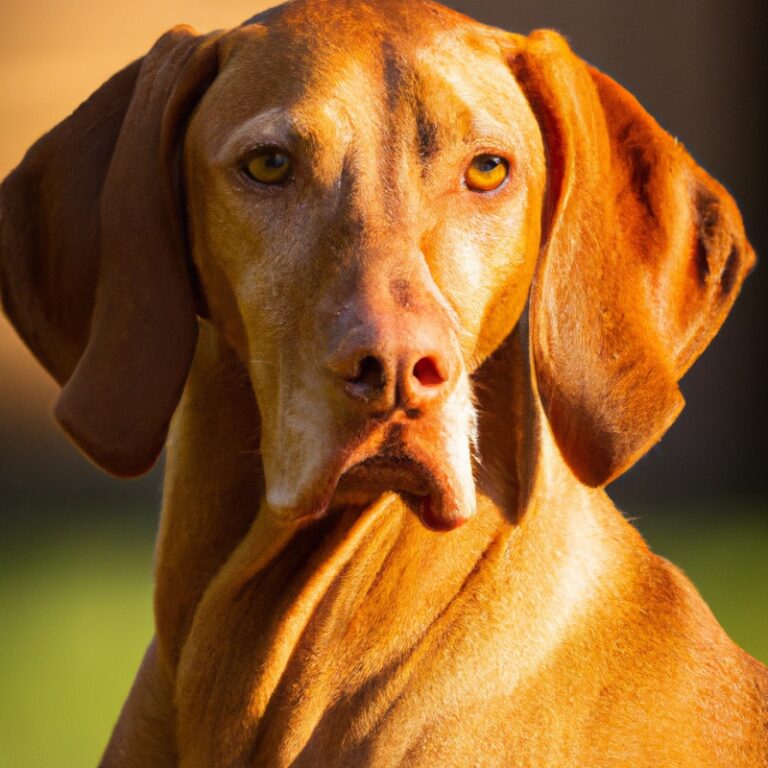How Do I Handle Vizsla’s Excessive Jumping On Guests When They Arrive?
Key Takeaways:
- Establish clear boundaries and reinforce consistent rules to discourage jumping behavior.
- Use positive reinforcement to redirect attention and reward calm behavior.
- Provide mental and physical stimulation to help expend excess energy and reduce jumping.
- Seek professional help if the jumping behavior persists or escalates despite your efforts.
Have you ever experienced the pure joy of being greeted by an enthusiastic Vizsla who can’t contain their excitement? While their exuberance is endearing, it can become a problem when they go overboard with jumping on guests.
But fear not! As an expert in Vizsla behavior and training, I’m here to guide you through practical techniques to manage this common issue.
In this article, we’ll delve into the reasons why Vizslas have a tendency to jump, explore effective training methods, and discover strategies to prevent jumping altogether. Get ready to turn your Vizsla into the perfect host!
| Problem | Solution |
| Excessive jumping on guests |
|
Understanding Vizsla Behavior
Jumping Behavior in Vizslas
Vizslas are known for their exuberant and energetic nature, and jumping behavior is a common issue that owners face.
This behavior is usually a sign of excitement and a way for them to greet their loved ones.
To address this, it’s important to provide proper outlets for their energy through regular exercise and mental stimulation.
Additionally, you can train your Vizsla to greet guests calmly by using positive reinforcement techniques.
Consistency and patience are key in modifying this behavior.
Remember to reward them for good behavior and avoid punishing or scolding them, as it can worsen the issue.

Why Vizslas Jump on Guests
Excitement and Social Nature of Vizslas
Vizslas are known for their excitement and social nature.
They get easily thrilled when their favorite human or guests come around.
Their wagging tail and jumping behavior can be a bit overwhelming for some people.
Vizslas want to show their affection and enthusiasm, but it’s important to teach them appropriate manners when greeting guests.
Positive reinforcement training, consistent boundaries, and redirecting their energy can help in managing their excitement and teaching them the right way to greet people.

Seeking Attention or Reinforcement
When your Vizsla jumps on guests, it may be seeking attention or reinforcement. This behavior can be addressed by redirecting their focus onto more appropriate actions, such as sitting or staying.
You can reinforce good behavior by rewarding your dog with treats or praise when they remain calm and greet guests politely.
Consistency is key in training them to avoid jumping and seeking attention in a more positive way. Remember to set clear boundaries and provide alternative outlets for their energy, such as regular exercise and mental stimulation.

Lack of Training or Boundaries
Lack of training or boundaries is a common reason why Vizslas jump on guests.
Without proper training, they may not understand that jumping is not acceptable behavior.
Similarly, if they don’t have clear boundaries, they may feel it’s okay to jump on people for attention or excitement.
Training sessions and consistent reinforcement of rules can help address this issue.
Providing boundaries and redirecting their attention to appropriate greetings will be beneficial.
Training Techniques to Stop Jumping Behavior
Consistency and Reinforcement
Consistency and reinforcement are key when attempting to address your Vizsla’s excessive jumping behavior. Set clear expectations and boundaries for your dog, and make sure everyone in your household understands and follows them consistently.
Reinforce positive behavior by rewarding your Vizsla for appropriate greetings.
Use treats, praise, or playtime when your dog remains calm when guests arrive. Consistency and reinforcement will help your Vizsla understand what is expected of them and encourage them to change their jumping behavior over time.
Teaching Appropriate Greetings
Teaching appropriate greetings is important when addressing your Vizsla’s jumping behavior. Here are some techniques you can try:
- Set boundaries: Teach your Vizsla to stay calm while guests arrive by using commands such as “sit” or “stay.”
- Consistency is key: Practice these greetings regularly with friends or family members, so your Vizsla becomes familiar with appropriate behavior.
- Positive reinforcement: Reward your Vizsla with treats or praise when they greet guests calmly and politely.
- Redirect their energy: Engage your Vizsla in a quick game or provide a toy to distract them from jumping on guests.
Remember, patience and consistency are essential when teaching appropriate greetings. With time and effort, your Vizsla will learn to greet guests calmly and respectfully.
Use of Commands and Positive Reinforcement
Using commands and positive reinforcement is an effective way to address your Vizsla’s jumping behavior.
Start by teaching him basic obedience commands like “Sit” and “Stay.” Whenever guests arrive, instruct your Vizsla to sit and reward him with praise and treats when he obeys.
Consistency is key, so make sure to reinforce the positive behavior consistently.
By doing so, your Vizsla will learn to associate sitting with positive outcomes and will be less likely to jump on guests.
Management Strategies to Prevent Jumping
Leash and Crate Training
Leash and crate training are effective methods for managing a Vizsla’s jumping behavior. When using a leash, make sure to hold it firmly to maintain control and prevent jumping.
Practice walking them on a leash to reinforce good behavior and discourage jumping.
Additionally, crate training can be helpful in teaching your Vizsla proper behavior when guests arrive. Utilize the crate as a safe space and reward calm behavior inside.
Gradually increase the time spent in the crate to build positive associations.
With consistency and patience, leash and crate training can address excessive jumping.
Distraction Techniques
Distraction techniques can be helpful in redirecting your Vizsla’s excessive jumping behavior.
Here are a few simple strategies you can try:
- Offer a toy or treat: When guests arrive, give your Vizsla a special toy or treat to focus their attention and keep them occupied.
- Use obedience commands: Teach your Vizsla basic obedience commands like “sit” or “stay.” When guests arrive, ask them to give your dog these commands, which can redirect their energy and prevent jumping.
- Engage in interactive play: Prior to your guests’ arrival, engage your Vizsla in some interactive play, such as fetching a ball or playing tug-of-war. This can help tire them out and reduce their excitement levels.
- Redirect their attention: If your Vizsla starts to jump on a guest, redirect their attention by calling their name or offering them a command. This can help shift their focus away from jumping.
Remember, consistency is key when using distraction techniques.
With patience and practice, you can help your Vizsla learn alternative behaviors and reduce their jumping tendencies.
Preemptive Exercise and Mental Stimulation
Preemptive exercise and mental stimulation are key to managing your Vizsla’s excessive jumping. Engaging in regular physical activity, such as daily walks or runs, helps tire out your energetic pup and reduces the likelihood of jumping behaviors.
Additionally, mental stimulation, such as puzzle toys or training sessions, keeps your Vizsla’s mind occupied and prevents boredom.
Incorporating these activities into your daily routine will help redirect your dog’s excess energy and provide a positive outlet for their jumping tendencies.
Addressing Jumping with Guests
Educating Guests about Vizsla Behavior
When guests are coming over, it’s important to educate them about Vizsla behavior.
- Explain that Vizslas are energetic breeds, prone to jumping when excited.
- Encourage guests to ignore jumping behavior and avoid rewarding it with attention.
- Suggest alternative ways for guests to greet the Vizsla, like offering a treat or engaging in calm play.
- Remind guests not to punish or scold the dog for jumping, as it can worsen the behavior.
- Provide information about Vizsla training methods and recommend resources for further reading.
Controlled Introductions and Avoiding Reinforcement
When introducing your Vizsla to guests, it’s important to maintain control and avoid reinforcing their jumping behavior. Here’s what you can do:
- Use a leash: Keep your Vizsla on a leash during introductions to maintain control and prevent jumping.
- Practice sit-command: Teach your Vizsla to sit and stay before meeting guests. Reinforce this behavior with treats and praise.
- Create a designated space: Set up a specific area where your Vizsla can greet guests calmly. Use a crate or baby gate if necessary.
- Ignore jumping behavior: Ignore your Vizsla’s jumping by turning away and avoiding eye contact. Give attention and praise only when all four paws are on the ground.
- Teach alternative behavior: Redirect your Vizsla’s jumping tendencies by teaching them an alternative behavior, such as shaking hands or offering a toy instead.
Remember, consistency and positive reinforcement are key when addressing jumping behavior. With time and patience, you can train your Vizsla to greet guests calmly and politely.
Redirection and Replacement Behaviors
When dealing with a Vizsla’s excessive jumping, redirection and replacement behaviors are key. Instead of punishing the jumping behavior, redirect your Vizsla’s energy towards a more appropriate behavior, such as sitting or offering a paw.
This helps to prevent jumping and rewards desired behaviors.
You can also replace the jumping behavior with an alternative, like a high-five or a game of fetch. Consistency and positive reinforcement are important for success.
Frequently Asked Questions (FAQs)
Can’t I just use punishment to stop my Vizsla from jumping?
Punishment might seem like a quick fix for stopping your Vizsla from jumping, but it’s not the most effective approach.
Using punishment can actually worsen the behavior in the long run.
Your Vizsla may become fearful or anxious, leading to more behavioral issues.
Instead, focus on positive reinforcement training and redirecting their energy.
Encourage calm behavior and reward them when they greet guests appropriately.
Consistency and patience will go a long way in curbing their jumping habit.
At what age can I start training my Vizsla to stop jumping?
You can start training your Vizsla to stop jumping at around 4-6 months of age. It’s important to address this behavior early on so it doesn’t become a habit.
Start by teaching your Vizsla the “off” command and rewarding them for keeping all four paws on the ground.
Consistency and positive reinforcement are key in training your Vizsla to stop jumping. Remember to be patient and consistent with your training efforts.
Are there any professional trainers or classes specifically for Vizslas?
Yes, there are professional trainers and classes specifically for Vizslas. Vizslas are a unique breed with specific training needs, and finding a trainer or class that specializes in their characteristics can be beneficial.
These trainers understand the breed’s energy levels, intelligence, and need for mental stimulation.
They can help address issues like excessive jumping on guests and teach you effective techniques to modify this behavior. Look for trainers who have experience working with Vizslas or participate in classes tailored specifically to this breed.
Final Verdict
Understanding Vizsla behavior is key to addressing the issue of excessive jumping on guests. Vizslas are naturally social and high-energy dogs, which can contribute to their jumping behavior.
However, through consistent training techniques and management strategies, this behavior can be effectively curbed.
It is important to educate guests about Vizsla behavior, implement controlled introductions, and redirect their energy towards appropriate behaviors. By employing these strategies and providing proper training and boundaries, Vizsla owners can overcome the challenge of excessive jumping and create a more harmonious environment for both their furry friends and guests.
Remember, patience, consistency, and positive reinforcement are the keys to success.







